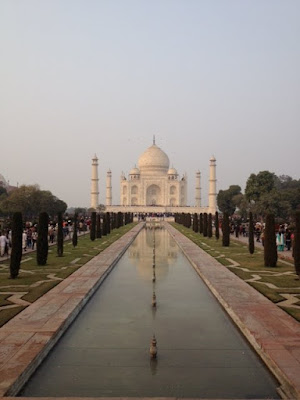The Wonder of the Taj Mahal
The final day of the 2011, traveling from Delhi to Agra to see the Taj Mahal and other sites within what is known as the Golden Triangle. Streets are passable at 8am, with traffic building all the way to Agra, some five hours and 240 kilometers away, and home to the Taj. We saw fields of yellow mustard and basmati rice, an oil refinery, and much (tame/working) animal life: water buffalo, goats, sheep, camels, elephants, snakes, monkeys and pigs.
First in Agra though, we explored the fort built by Akbar of red sandstone, much more impressive than the Red Fort in Delhi, or so we were told. We only drove around Delhi's Red Fort because it was being used as practice grounds by the Indian military for an upcoming parade. We could venture into the various courtyards and rooms of Agra's fortified fort, seeing where the public and private courts were held by Akbar, with his wives behind screens on either side of him to overhear his rulings so they could make decisions in his absence; seeing the library, the bedrooms, the corridors used by the concubines, and the fountains. Very elaborate carvings, many representing Hindu, Muslin and Christian faiths as Akbar wanted to show him being open to different religions.
We've learned a great deal about the Mughal Empire which ruled here for 400 years, of which Akbar was the third, father to Shah Jahan, who commissioned the Taj Mahal in honor of his second and most beloved Hindu wife, Mumtaz. The Taj is as spectacular as any picture you've seen, even with thousands of Indian tourists lined up to see the tombs of Mumtaz and her husband. No one sees their actual tombs as they are out of sight in the basement. Shah Jahan built it based on his love for Mumtaz fulfilling a promise he made to her on her deathbed. (She died of blood loss following the birth of her fourteenth child, having followed Shah Jahan against his wishes to the camp he was using as he was trying to repel a revolt. He promised never to remarry, though he spent time with concubines; to raise their children, and to build something for which to remember her. At that he royally succeeded.
Fountains front the tomb, but are rarely used because of the beautiful reflection in the pools tourists want to see in their photos. White marble is everywhere, except on the right side of the roof line, which is of a dark marble to ward off evil spirits. The monument is adorned with precious and semi-precious stones, marble inlaid with translucent stones in lotus and jasmine flowers and Hindu calligraphy. Archways were designed on the sides with wonderful acoustics. You can clearly hear whispers from some on the other side of the arch.
Though its foundation consists of teak and ebony, there is concern that the Taj is sinking as the river on which it is built is drying out. From what we've heard, the current prime minister filled in some of the river in hopes of building a huge hotel to take in the views of the Taj and the Red Fort. Luckily the courts overruled this because it would have interfered with the views between them.
During the war between Pakistan and Bangladesh, India was concerned about this masterpiece being bombed. To prevent this, the dome was covered in black, with the evidence being huge hooks onto which the drape was attached. Today these hooks are used by those cleaning the dome.
A short distance away across the Yamuna River is Agra Fort, built by Emperor Akbar, where Shah Jahan was held prisoner by his son the last eight years of his life, preventing Shah Jahan from spending any more of his forthcoming inheritance. Shah Jahan had already spent Rs45 million on the Taj, and has started building a smaller black marble Taj for himself. At least Shah Jahan had a view of the Taj. His eldest daughter took care of him from one of the two Golden Palaces built for his daughters. In addition, there was a palace for each of Akbar's three wives. Though the fort was built in the mid-1700's, their baths were luxuriously scented with rose and jasmine.
Fatehpur Sikri, 40 kilometers west of Agra is famous for the spiritual deeds of Shaikh Salin Chishti, who sacrificed his six month old son so that his son's spirit would transfer itself to Akbar's wife's womb and bear him a son and successor to the throne. Though mute, his son told Shaikh Salin Chishti it was Allah’s wish.
Akbar had a public and private hall, from which some people were sentenced to death by being crushed by elephants. Akbar was said to have a favorite execution elephant for which Akbar had a special tomb built upon the elephant's death. When he was attending to this business, he listened to melodies played by an orchestra seated on a platform in the center of a huge reflection pool or played Parcheesi with sixteen concubines as human players. One room was enhanced with real diamonds, making it a very bright spot at night with the use of a single candle.



1 Comments:
Hey nomad.
I was just pulling out your card to give you a call and decided to peek at your blog. No need to call given you are in India. I took a cat class with you at superior charters. Hope to get you and my wife together for a class this summer. Good luck and good travels
Tom Sult
Post a Comment
<< Home